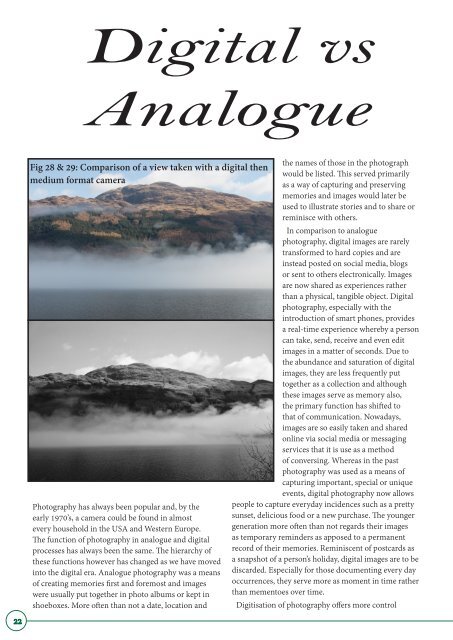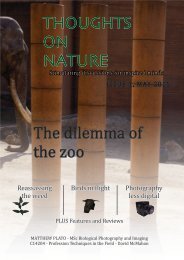Saving Wild Cats
You also want an ePaper? Increase the reach of your titles
YUMPU automatically turns print PDFs into web optimized ePapers that Google loves.
Digital vs<br />
Analogue<br />
Fig 28 & 29: Comparison of a view taken with a digital then<br />
medium format camera<br />
Photography has always been popular and, by the<br />
early 1970’s, a camera could be found in almost<br />
every household in the USA and Western Europe.<br />
The function of photography in analogue and digital<br />
processes has always been the same. The hierarchy of<br />
these functions however has changed as we have moved<br />
into the digital era. Analogue photography was a means<br />
of creating memories first and foremost and images<br />
were usually put together in photo albums or kept in<br />
shoeboxes. More often than not a date, location and<br />
the names of those in the photograph<br />
would be listed. This served primarily<br />
as a way of capturing and preserving<br />
memories and images would later be<br />
used to illustrate stories and to share or<br />
reminisce with others.<br />
In comparison to analogue<br />
photography, digital images are rarely<br />
transformed to hard copies and are<br />
instead posted on social media, blogs<br />
or sent to others electronically. Images<br />
are now shared as experiences rather<br />
than a physical, tangible object. Digital<br />
photography, especially with the<br />
introduction of smart phones, provides<br />
a real-time experience whereby a person<br />
can take, send, receive and even edit<br />
images in a matter of seconds. Due to<br />
the abundance and saturation of digital<br />
images, they are less frequently put<br />
together as a collection and although<br />
these images serve as memory also,<br />
the primary function has shifted to<br />
that of communication. Nowadays,<br />
images are so easily taken and shared<br />
online via social media or messaging<br />
services that it is use as a method<br />
of conversing. Whereas in the past<br />
photography was used as a means of<br />
capturing important, special or unique<br />
events, digital photography now allows<br />
people to capture everyday incidences such as a pretty<br />
sunset, delicious food or a new purchase. The younger<br />
generation more often than not regards their images<br />
as temporary reminders as apposed to a permanent<br />
record of their memories. Reminiscent of postcards as<br />
a snapshot of a person’s holiday, digital images are to be<br />
discarded. Especially for those documenting every day<br />
occurrences, they serve more as moment in time rather<br />
than mementoes over time.<br />
Digitisation of photography offers more control<br />
over the final outcome of our images, as we are able<br />
to process, edit and manipulate them with both ease<br />
and speed. Other than the initial cost of a camera,<br />
editing software and equipment, be it a laptop, smart<br />
phone or desktop computer, digital photography is a<br />
relatively inexpensive process. Compared with analogue<br />
photography where there are only a certain number of<br />
exposures per roll of film, digital photography offers an<br />
almost endless capacity for image capture. Along with<br />
the ability to review and delete images as you go, there<br />
is no real need to be selective with regards to where,<br />
when and how<br />
often you release<br />
the shutter. As<br />
mentioned before<br />
however, this<br />
saturation of<br />
images is what<br />
leads to them<br />
being overlooked,<br />
left aside and<br />
perhaps stored<br />
in a computer<br />
file never to be<br />
looked at again.<br />
With analogue<br />
photography<br />
more care and<br />
consideration<br />
is taken before<br />
taking a picture<br />
and there is<br />
a sense of<br />
anticipation<br />
and pride over<br />
what will be on<br />
the film when<br />
it is developed.<br />
The downside<br />
of analogue<br />
photography<br />
is that if an<br />
image goes<br />
wrong, it won’t be apparent until after its been taken<br />
and developed. With digital cameras, reviewing the<br />
image allows you to check the settings are correct and<br />
depending on the subject, enables you to take as many<br />
images as needed to get it right. This is a wonderful<br />
development as with analogue photography, a wasted<br />
film costs not only money but also time spent capturing<br />
and developing the images. Of course, things can go<br />
wrong with digital photography as well in the form of<br />
erased or faulty memory cards and depleted batteries.<br />
For professional photographers using digital SLRs,<br />
the ability to review images and make adjustments<br />
accordingly is of great benefit to their work. Likewise,<br />
the average person taking images of a special event such<br />
as a birthday celebration or a wedding will be safe in<br />
the knowledge that their photograph has turned out<br />
ok and the moment has been captured successfully.<br />
However, advances in photography have taken away<br />
the ability for one to take a picture and forget about<br />
it. Analogue photography allows you to appreciate<br />
your surroundings and to stay in the moment as once<br />
you have taken an<br />
image there is no<br />
Fig 30: A digitally coloured image of the view<br />
going back. With<br />
from Loch Lomond<br />
digital photography,<br />
there is a tendency<br />
to take a picture<br />
then scrutinize<br />
over it whilst<br />
simultaneously<br />
missing what is<br />
going on around<br />
you.<br />
Although unique<br />
entities, analogue<br />
and digital<br />
photography do<br />
not always need to<br />
be thought of as<br />
separate from one<br />
another. Advances<br />
in technology and<br />
image manipulation<br />
can be applied to<br />
analogue techniques<br />
also. The scanning<br />
of film allows us<br />
to convert our<br />
negatives into<br />
a digital image.<br />
An under or<br />
overexposed image<br />
may be salvaged through editing and adjustments to<br />
exposure, highlights and shadows. An image can be<br />
transformed from black and white to colour using<br />
colourisation techniques and images can be stored or<br />
shared without incurring the cost of printing.<br />
Even with such advances in technology, there is room<br />
for both digital and analogue photography. Digital<br />
brings with it fresh, modern images whereas analogue<br />
produces classic, timeless pieces that remind us of the<br />
history of photography.<br />
23














